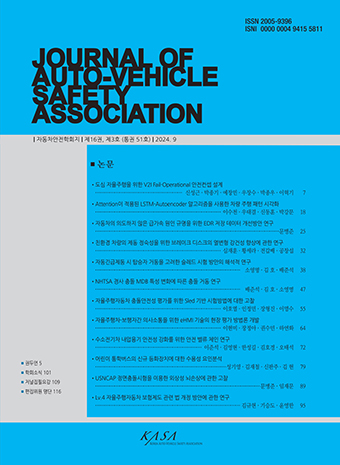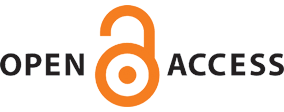-

-
Longitudinal Motion Planning Strategy for Autonomous Driving in Non-signalized Crosswalk
비신호 횡단보도 환경 내 자율주행을 위한 종방향 거동 전략 연구
-
Youngmin Yoon, Sangyoon Kim, Changhee Kim, Jinsoo Michael Yoo, Jongcherl Park, Kyongsu Yi
윤영민, 김상윤, 김창희, 유진수, 박종철, 이경수
- This paper presents a method of longitudinal motion planning of autonomous vehicles to deal with the non-signalized crosswalk environment. Based on the …
- This paper presents a method of longitudinal motion planning of autonomous vehicles to deal with the non-signalized crosswalk environment. Based on the traffic laws, vehicles should slow down when passing the non-signalized crosswalk to prepare for situations where a nearby pedestrian starts to cross. If a pedestrian is in the crossing phase, vehicles should stop in front of the stop-line and wait until the pedestrian finishes the crossing maneuver. To realize these behaviors in autonomous vehicles, the driving mode and corresponding driving strategy are determined when vehicles encounter the crosswalk. The driving mode is determined according to the behavioral status of the nearby pedestrian. Longitudinal motion for the stopping or passing maneuver is planned according to the determined driving mode. The proposed algorithm has been validated via autonomous driving tests with our test vehicle in a real world. The test results show that the proposed algorithm enables the test vehicle to follow the traffic laws and behave safely against crossing pedestrians in the non-signalized crosswalk. - COLLAPSE
-
Longitudinal Motion Planning Strategy for Autonomous Driving in Non-signalized Crosswalk
-

-
Proactive Autonomous Emergency Braking System for the Elderly Driver
고령운전자를 위한 자동긴급제동시스템 기술 개발
-
Donghoon Shin
신동훈
- This paper describes autonomous emergency braking systems (AEB) for elderly drivers designed to consider their driving characteristics. With aging, perception-reaction time, and …
- This paper describes autonomous emergency braking systems (AEB) for elderly drivers designed to consider their driving characteristics. With aging, perception-reaction time, and decision-making time increase accordingly. Without being aware of these performance degradations, however, changes in driving patterns due to increased alertness while driving lead to vehicle crashes. Therefore, it is necessary to develop an autonomous emergency braking system by incorporating the characteristics of the elderly driver. In order to enhance the driver acceptance of older people, perception-reaction time, alertness, and ride comfort need to be considered for conventional autonomous emergency braking systems (C-AEB). Proactive AEB(P-AEB) algorithm has been proposed to reflect human factor of elderly driver above. The performance of the proposed algorithm has been evaluated through MATLAB simulink simulation studies. It has been shown from the computer simulations that the proposed P-AEB algorithm enhances the driver acceptance of older people by improving ride comfort while ensuring safety of vehicle. - COLLAPSE
-
Proactive Autonomous Emergency Braking System for the Elderly Driver
-

-
Obstacle Detection and Safe Landing Site Selection for Delivery Drones at Delivery Destinations without Prior Information
사전 정보가 없는 배송지에서 장애물 탐지 및 배송 드론의 안전 착륙 지점 선정 기법
-
Min Chol Seo, Sang Ik Han
서민철, 한상익
- The delivery using drones has been attracting attention because it can innovatively reduce the delivery time from the time of order to …
- The delivery using drones has been attracting attention because it can innovatively reduce the delivery time from the time of order to completion of delivery compared to the current delivery system, and there have been pilot projects conducted for safe drone delivery. However, the current drone delivery system has the disadvantage of limiting the operational efficiency offered by fully autonomous delivery drones in that drones mainly deliver goods to pre-set landing sites or delivery bases, and the final delivery is still made by humans. In this paper, to overcome these limitations, we propose obstacle detection and landing site selection algorithm based on a vision sensor that enables safe drone landing at the delivery location of the product orderer, and experimentally prove the possibility of station-to-door delivery. The proposed algorithm forms a 3D map of point cloud based on simultaneous localization and mapping (SLAM) technology and presents a grid segmentation technique, allowing drones to stably find a landing site even in places without prior information. We aims to verify the performance of the proposed algorithm through streaming data received from the drone. - COLLAPSE
-
Obstacle Detection and Safe Landing Site Selection for Delivery Drones at Delivery Destinations without Prior Information
-

-
Development of Electric Vehicle Crash Scenarios and Safety Testing Methods Considering Road Infrastructure
도로 인프라를 고려한 전기자동차 충돌안전 시험법 개발
-
Seung-Jun Hong, Jong-Wook Lee, Gyu-Hyun Kim
홍승준, 이종욱, 김규현
- In this study, an analysis was conducted on internal and external factors related to fires in electric vehicles in order to improve …
- In this study, an analysis was conducted on internal and external factors related to fires in electric vehicles in order to improve the safety of electric vehicles against fire accidents. To conduct the analysis, field survey data conducted on actual electric vehicle fire accidents were used, and accident-related statistical data was used. Among them, as a result of analyzing the internal factors related to fire accidents in electric vehicles, it was confirmed that high-voltage batteries are an important factor in fire accidents caused by internal factors of electric vehicles. An analysis of external factors for fire accidents of electric vehicles was also conducted in this study. The largest number of electric vehicle accidents that occurred on public roads were mainly caused by physical external forces such as collisions. Therefore, strengthening the safety of this road infrastructure could be an additional solution to improve the fire safety of electric vehicles. As a result, based on car accident cases, two crash scenarios based on road infrastructure were derived, each of which simulates a high-speed frontal collision situation and a lower-end collision situation. Additionally, detailed test methods for these scenarios were developed. - COLLAPSE
-
Development of Electric Vehicle Crash Scenarios and Safety Testing Methods Considering Road Infrastructure
-

-
A Study of Vehicle and Occupant behavior during Side Impact at Different Impact Locations and Angles
측면 충돌 시 차량의 충돌 위치 및 충돌 각도에 따른 차량 및 승객 거동
-
Junsuk Bae, Ho Kim, Young Myoung So
배준석, 김호, 소영명
- As the autonomous vehicle is to come to the commercial market, passive safety of the vehicles becomes ever more important, since more …
- As the autonomous vehicle is to come to the commercial market, passive safety of the vehicles becomes ever more important, since more responsibility of the car crash accidents will be imposed on the car makers. To cope with such a requirements, comprehensive studies are under progress in car OEM’s as well as relevant institutes. In this study FE models of two identical family sedans are utilized to investigate the effect of crash parameters like crash impact locations, and impact angle. Relationship between structural behavior of the car and the dummy injury measures is studied. - COLLAPSE
-
A Study of Vehicle and Occupant behavior during Side Impact at Different Impact Locations and Angles
-

-
A Study on the Consistency of Defrosting Performance of the Windshield in Auto-vehicles
자동차 전면 유리의 제상 성능 정합성 검증 연구
-
Subin Kim, Youngjae Kim, Youn-Jea Kim
김수빈, 김영재, 김윤제
- The windshield of a vehicle plays an important role in ensuring driver safety and maintaining visibility. To prevent issues such as frost …
- The windshield of a vehicle plays an important role in ensuring driver safety and maintaining visibility. To prevent issues such as frost and mist from occurring inside and outside the vehicle, research related to the defrosting performance of the windshield is being conducted. Evaluating defrosting performance requires accurate thermal flow analyses. Therefore, in this study, a defrosting duct was constructed within a chamber at an actual vehicle scale to evaluate its performance, and a finite element model was developed and verified. To evaluate defrosting performance, the temperature of the windshield was measured under condition with a mass flow rate of 0.1 kg/s, which corresponds to that of a typical midsize vehicle. A total of 45 thermocouples were arranged at equal intervals of 9 widths and 5 lengths on the windshield to measure the temperature and compare it with the temperature predicted through finite element analysis. A volume grid was created in the main flow area to ensure accurate thermal flow analyses, and a prism layer was added at the interface between the windshield and fluid. In total, 6 million grid systems were formed. Comparing the temperature fields of the experimental results and the finite element analysis results confirmed a similar defrosting pattern, with an average temperature difference of 0.64K. - COLLAPSE
-
A Study on the Consistency of Defrosting Performance of the Windshield in Auto-vehicles
-

-
Development of a Method for Health Monitoring of Rotating Object for Mobility based on Multiple RLS Algorithm
다중 재귀 최소 자승 추정 알고리즘 기반 모빌리티의 회전체 건전성 모니터링 방법 개발
-
Hanbyeol La, Jiung Lee, Kwangseok Oh
라한별, 이지웅, 오광석
- This study presents a method for health monitoring of rotating objects for mobility based on multiple recursive least squares(RLS) algorithms. The performance …
- This study presents a method for health monitoring of rotating objects for mobility based on multiple recursive least squares(RLS) algorithms. The performance degradation of the rotating objects causes low handing / low driving performances and even fatal accidents. Therefore, health monitoring algorithm of rotating objects is one of the important technologies for mobility fail-safe and maintenance areas. In order for health monitoring of rotating objects, four recursive least squares algorithms with forgetting factor were designed in this study. The health monitoring algorithm proposed in this study consists of two steps such as uncertainty estimation and parameter changes estimation. In order to improve estimation accuracy, time delay function was applied to the estimated signals based on the first order differential equation and forgetting factors used for the RLS were reasonably tuned. The health monitoring algorithm was constructed in Matlab/Simulink environment and simulation-based performance evaluation was conducted using DC motor model. The evaluation results showed that the proposed algorithm estimates the actual parameter differences reasonably using velocity and current information. - COLLAPSE
-
Development of a Method for Health Monitoring of Rotating Object for Mobility based on Multiple RLS Algorithm
-

-
Considerations for Virtual Vehicle Crash Test
자동차 가상충돌시험을 위한 고려사항
-
Kyungji Kim, Jaeho Shin, Kyeonghee Han
김경진, 신재호, 한경희
- Computer simulation significantly reduces the high costs associated with actual crash tests and is expanding due to its ability to analyze various …
- Computer simulation significantly reduces the high costs associated with actual crash tests and is expanding due to its ability to analyze various test results quantitatively that are difficult to measure in real tests. Research on evaluation technologies is limited according to the finite element analysis, which aims to replace structural verification testing. In this study, considerations for virtual crash tests were derived, and the validity of the zero-energy mode (hourglass mode) was analyzed as part of the considerations for validating the results of vehicle crash simulations. The study reflects on the considerations for virtual crash tests and the variation in hourglass coefficient values affects the occurrence of the hourglass mode. As the hourglass coefficient changes, the maximum hourglass energy reaches over 5% of the maximum internal energy, necessitating a conservative review. A comprehensive study of the maximum hourglass energy is required, considering additional analysis results for various models and collision conditions. - COLLAPSE
-
Considerations for Virtual Vehicle Crash Test
Journal Informaiton
 Journal of Auto-vehicle Safety Association
Journal of Auto-vehicle Safety Association
Journal Informaiton
Journal Informaiton - close
 Journal of Auto-vehicle Safety Association
Journal of Auto-vehicle Safety Association









